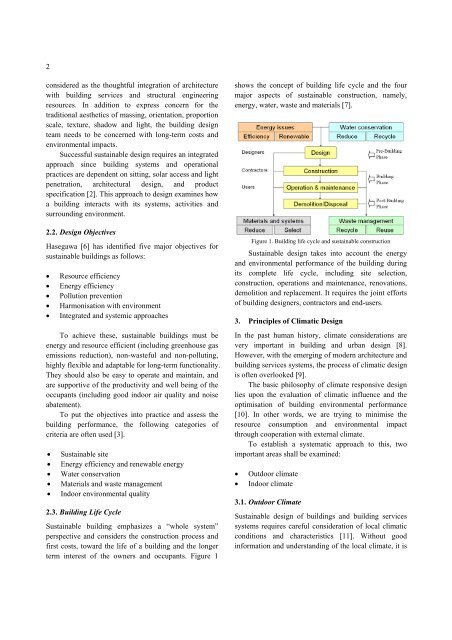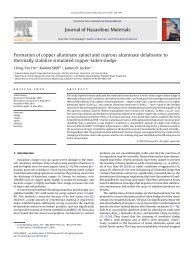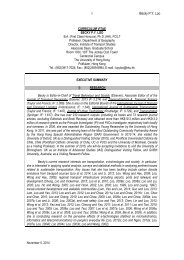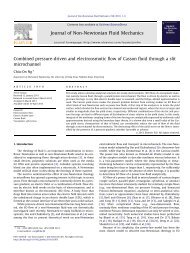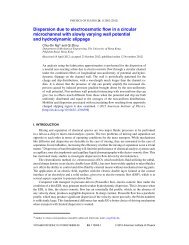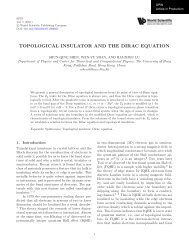sustainable building technologies for hot and humid climates
sustainable building technologies for hot and humid climates
sustainable building technologies for hot and humid climates
Create successful ePaper yourself
Turn your PDF publications into a flip-book with our unique Google optimized e-Paper software.
2<br />
considered as the thoughtful integration of architecture<br />
with <strong>building</strong> services <strong>and</strong> structural engineering<br />
resources. In addition to express concern <strong>for</strong> the<br />
traditional aesthetics of massing, orientation, proportion<br />
scale, texture, shadow <strong>and</strong> light, the <strong>building</strong> design<br />
team needs to be concerned with long-term costs <strong>and</strong><br />
environmental impacts.<br />
Successful <strong>sustainable</strong> design requires an integrated<br />
approach since <strong>building</strong> systems <strong>and</strong> operational<br />
practices are dependent on sitting, solar access <strong>and</strong> light<br />
penetration, architectural design, <strong>and</strong> product<br />
specification [2]. This approach to design examines how<br />
a <strong>building</strong> interacts with its systems, activities <strong>and</strong><br />
surrounding environment.<br />
2.2. Design Objectives<br />
Hasegawa [6] has identified five major objectives <strong>for</strong><br />
<strong>sustainable</strong> <strong>building</strong>s as follows:<br />
• Resource efficiency<br />
• Energy efficiency<br />
• Pollution prevention<br />
• Harmonisation with environment<br />
• Integrated <strong>and</strong> systemic approaches<br />
To achieve these, <strong>sustainable</strong> <strong>building</strong>s must be<br />
energy <strong>and</strong> resource efficient (including greenhouse gas<br />
emissions reduction), non-wasteful <strong>and</strong> non-polluting,<br />
highly flexible <strong>and</strong> adaptable <strong>for</strong> long-term functionality.<br />
They should also be easy to operate <strong>and</strong> maintain, <strong>and</strong><br />
are supportive of the productivity <strong>and</strong> well being of the<br />
occupants (including good indoor air quality <strong>and</strong> noise<br />
abatement).<br />
To put the objectives into practice <strong>and</strong> assess the<br />
<strong>building</strong> per<strong>for</strong>mance, the following categories of<br />
criteria are often used [3].<br />
• Sustainable site<br />
• Energy efficiency <strong>and</strong> renewable energy<br />
• Water conservation<br />
• Materials <strong>and</strong> waste management<br />
• Indoor environmental quality<br />
2.3. Building Life Cycle<br />
Sustainable <strong>building</strong> emphasizes a “whole system”<br />
perspective <strong>and</strong> considers the construction process <strong>and</strong><br />
first costs, toward the life of a <strong>building</strong> <strong>and</strong> the longer<br />
term interest of the owners <strong>and</strong> occupants. Figure 1<br />
shows the concept of <strong>building</strong> life cycle <strong>and</strong> the four<br />
major aspects of <strong>sustainable</strong> construction, namely,<br />
energy, water, waste <strong>and</strong> materials [7].<br />
Figure 1. Building life cycle <strong>and</strong> <strong>sustainable</strong> construction<br />
Sustainable design takes into account the energy<br />
<strong>and</strong> environmental per<strong>for</strong>mance of the <strong>building</strong> during<br />
its complete life cycle, including site selection,<br />
construction, operations <strong>and</strong> maintenance, renovations,<br />
demolition <strong>and</strong> replacement. It requires the joint ef<strong>for</strong>ts<br />
of <strong>building</strong> designers, contractors <strong>and</strong> end-users.<br />
3. Principles of Climatic Design<br />
In the past human history, climate considerations are<br />
very important in <strong>building</strong> <strong>and</strong> urban design [8].<br />
However, with the emerging of modern architecture <strong>and</strong><br />
<strong>building</strong> services systems, the process of climatic design<br />
is often overlooked [9].<br />
The basic philosophy of climate responsive design<br />
lies upon the evaluation of climatic influence <strong>and</strong> the<br />
optimisation of <strong>building</strong> environmental per<strong>for</strong>mance<br />
[10]. In other words, we are trying to minimise the<br />
resource consumption <strong>and</strong> environmental impact<br />
through cooperation with external climate.<br />
To establish a systematic approach to this, two<br />
important areas shall be examined:<br />
• Outdoor climate<br />
• Indoor climate<br />
3.1. Outdoor Climate<br />
Sustainable design of <strong>building</strong>s <strong>and</strong> <strong>building</strong> services<br />
systems requires careful consideration of local climatic<br />
conditions <strong>and</strong> characteristics [11]. Without good<br />
in<strong>for</strong>mation <strong>and</strong> underst<strong>and</strong>ing of the local climate, it is


